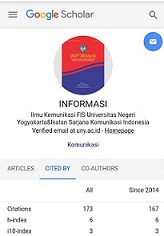Structural equation modeling of internet of things (IoT) adoption for Indonesian Village-Owned Enterprises (BUMDes)
DOI:
https://doi.org/10.21831/informasi.v51i1.40170Keywords:
Public Sector Management, Structural Equation Modeling (SEM), IoT Adoption, Indonesian Village-Owned Enterprises (BUMDes), Technology Acceptance Model.Abstract
This study seeks to examine the antecedents of Internet of Things (IoT) intention and adoption of Indonesian village-owned enterprises (Badan Usaha Milik Desa, BUMDes) by applying the Technology Acceptance Model (TAM). The respondents comprised 237 managers and staff of BUMDes in Aceh, Indonesia. A questionnaire was designed to examine perceived usefulness of IoT on the product and service empowerment, perceived ease of use of IoT, and perceived credibility on IoT, intention to use the technology, and adoption of IoT to the community empowerment in the village setting. The data were analyzed using partial least squares structural equation modeling (PLS-SEM). The generated model of IoT showed three significant direct paths between perceived usefulness, perceived credibility on the IoT, and intention as well as between intention and adoption. The re-specified model of IoT adoption indicated two significant direct paths (perceived usefulness to intention and intention to adoption) and introduced three new paths (direct paths from perceived usefulness, perceived ease of use, and perceived credibility to adoption). The final model also established partial mediating effects of intention between Perceived Usefulness, Perceived Ease of Use, and IoT adoption. This study suggests the relevance of TAM to explain IoT adoption in Indonesian village-owned companies.
References
Abd Rahman, A., Kamarulzaman, N. H., & Sambasivan, M. (2013). A study on organizational culture, performance, and technological adoption behaviours of Malaysian food-processing SMEs. Pertanika Journal of Social Sciences & Humanities, 21, 231-256. Retrieved from http://psasir.upm.edu.my/id/eprint/28340/
Abdullah, F., Ward, R., & Ahmed, E. (2016). Investigating the influence of the most commonly used external variables of TAM on students' Perceived Ease of Use (PEOU) and Perceived Usefulness (PU) of e-portfolios. Computers in Human Behavior, 63, 75-90. doi:https://doi.org/10.1016/j.chb.2016.05.014
Al-Jader, R. A., & Sentosa, I. (2015). A Conceptual Development on the Mediating Role of E-Service Recovery on The Relationship between Customer Determinants and Customer Retentions in The Airline Industry in Malaysia (A Structural Equation Modelling Approach). Indian Journal of Commerce and Management Studies, 6(1), 103. Retrieved from http://jurnal.unsyiah.ac.id/AICS-Social/article/view/10348
Azjen, I. (1980). Understanding attitudes and predicting social behavior. Englewood Cliffs, NJ: Prentice-Hall.
Bagozzi, R. P., & Yi, Y. (1988). On the evaluation of structural equation models. Journal of the academy of marketing science, 16(1), 74-94. https://doi.org/10.1007/BF02723327
Davis, F. D. (1989). Perceived usefulness, perceived ease of use, and user acceptance of information technology. MIS quarterly, 319-340. DOI:10.2307/249008
Davis, F. D., Bagozzi, R. P., & Warshaw, P. R. (1989). User acceptance of computer technology: a comparison of two theoretical models. Management science, 35(8), 982-1003. DOI:10.1287/mnsc.35.8.982
Florida, R. (2002). The rise of the creative class (Vol. 9): Basic books New York.
Ganesan, S. (1994). Determinants of long-term orientation in buyer-seller relationships. Journal of marketing, 58(2), 1-19. https://doi.org/10.2307/1252265
Goyal, A., Maity, M., Thakur, R., & Srivastava, M. (2013). Customer usage intention of mobile commerce in India: an empirical study. Journal of Indian Business Research. 5 (1), 52-72. https://doi.org/10.1108/17554191311303385
Hadi, A. (2018). Bridging Indonesia's Digital Divide: Rural-Urban Linkages? Jurnal Ilmu Sosial dan Ilmu Politik, 22, 17. doi:10.22146/jsp.31835
Hair, J. F., Black, W. C., Babin, B. J., & Anderson, R. E. (2013). Multivariate data analysis (7 ed.). Pearson Education Limited.
Hamid, A. A., Razak, F. Z. A., Bakar, A. A., & Abdullah, W. S. W. (2016). The Effects of Perceived Usefulness and Perceived Ease of Use on Continuance Intention to Use E-Government. Procedia Economics and Finance, 35, 644-649. doi:https://doi.org/10.1016/S2212-5671(16)00079-4
Hoffman, D. L., Novak, T. P., & Peralta, M. (1999). Building consumer trust online. Communications of the ACM, 42(4), 80-85. DOI: 10.1145/299157.299175
Hsu Meng, H., Chiu Chao, M., & Ju Teresa, L. (2004). Determinants of continued use of the WWW: an integration of two theoretical models. Industrial Management & Data Systems, 104(9), 766-775. doi:10.1108/02635570410567757
Ibrahim, A. M. (2018). Strategizing small and medium enterprises development through ICT-related innovations adoption: moderating influence of gender, age and experience. Informasi, 48(1), 15-32. https://doi.org/10.21831/informasi.v48i1.18417
Jaafreh, A. B. (2018). The effect factors in the adoption of Internet of Things (IoT) technology in the SME in KSA: An empirical study. International Review of Management and Business Research, 7(1), 135-148. DOI:10.30543/7-1(2018)-13
Karahoca, A., Karahoca, D., & Aksí¶z, M. (2018). Examining intention to adopt to internet of things in healthcare technology products. Kybernetes, 47(4), 742-770. doi:10.1108/K-02-2017-0045
Kim, Y., Park, Y., & Choi, J. (2017). A study on the adoption of IoT smart home service: using Value-based Adoption Model. Total Quality Management & Business Excellence, 28(9-10), 1149-1165. https://doi.org/10.1080/14783363.2017.1310708
Koksal, M. H. (2016). The intentions of Lebanese consumers to adopt mobile banking. International Journal of bank marketing. 34 (3), 327-346. https://doi.org/10.1108/IJBM-03-2015-0025
Kucukusta, D., Law, R., Besbes, A., & Legohérel, P. (2015). Re-examining perceived usefulness and ease of use in online booking. International Journal of Contemporary Hospitality Management. 27 (2), 185-198. https://doi.org/10.1108/IJCHM-09-2013-0413
Lubis, A., Rustam, & Muda, I. (2017). Factors affecting the cost of agency of village owned enterprise (BUMDEs) in Indonesia. International Journal of Economic Research, 14, 151-166.
Marangunić, N., & Granić, A. (2015). Technology acceptance model: a literature review from 1986 to 2013. Universal Access in the Information Society, 14(1), 81-95. doi:10.1007/s10209-014-0348-1
Moon, J.-W., & Kim, Y.-G. (2001). Extending the TAM for a World-Wide-Web context. Information & management, 38(4), 217-230. https://doi.org/10.1016/S0378-7206(00)00061-6
Nurchim, N., & Nofikasari, I. (2018). Pemodelan adopsi teknologi digital guna mewujudkan desa pintar. Retrieved from https://publikasiilmiah.ums.ac.id/handle/11617/9871
Polatoglu, V. N., & Ekin, S. (2001). An empirical investigation of the Turkish consumers' acceptance of Internet banking services. International Journal of bank marketing. 19 (4), 156-165. https://doi.org/10.1108/02652320110392527
Popescu, G. H. (2015). The economic value of the industrial internet of things. Journal of Self-Governance and Management Economics, 3(2), 86-91. Retrieved from https://www.addletonacademicpublishers.com/contents-jsme/313-volume-3-2-2015/2475-the-economic-value-of-the-industrial-internet-of-things
Rayes, A., & Salam, S. (2019). Internet of Things (IoT) Overview. In Internet of Things From Hype to Reality: The Road to Digitization (pp. 1-35). Springer International Publishing.
Rengiah, P., & Sentosa, I. (2015). Entrepreneurship education and entrepreneurial intentions among Malaysian university students: Developing a hypothesised model through Structural Equation Modelling. Australian Journal of Basic and Applied Sciences, 9(7), 703-710. Retrieved from http://www.ajbasweb.com/old/ajbas/2015/April/703-710.pdf
Saade, R., Nebebe, F., & Tan, W. (2007). Viability of the" technology acceptance model" in multimedia learning environments: a comparative study. Interdisciplinary Journal of E-Learning and Learning Objects, 3(1), 175-184. Retrieved from https://www.learntechlib.org/p/44804/.
Sentosa, I., Bambang, B. S., Ming, C. W. M. C. W., & Kamaria, N. K. N. M. (2012). A structural equation modeling of internet banking usage in Malaysia. Journal of Art Science & Commerce, 3(1), 75-86. Retrieved from https://repository.unsri.ac.id/14568/
Srirejeki, K. (2018). Empowering the role of village owned enterprise (BUMDes) for rural development: Case in Indonesia. Jurnal Akuntansi, Manajemen dan Ekonomi, 20 (1). 5-10. Retrieved from http://jos.unsoed.ac.id/index.php/jame/article/view/1018
Statista. (2020). Countries with the highest number of internet users 2019. Retrieved from https://www.statista.com/statistics/262966/number-of-internet-users-in-selected-countries/
Tabachnick, B. G., Fidell, L. S., & Ullman, J. B. (2012). Using multivariate statistics (6 ed.). Pearson.
Venkatesh, V., & Davis, F. D. (2000). A theoretical extension of the technology acceptance model: Four longitudinal field studies. Management science, 46(2), 186-204. https://doi.org/10.1287/mnsc.46.2.186.11926
Wang, Y. S., Wang, Y. M., Lin, H. H., & Tang, T. I. (2003). Determinants of user acceptance of Internet banking: an empirical study. International journal of service industry management. 14 (5), 501-519. https://doi.org/10.1108/09564230310500192
Yan, R. (2017). Optimization approach for increasing revenue of perishable product supply chain with the Internet of Things. Industrial Management & Data Systems, 117(4), 729-741. doi:10.1108/IMDS-07-2016-0297
Zaidi, M. F. A., & Faizal, M. (2017). The IoT readiness of SMEs in Malaysia: are they worthwhile for investigation. Paper presented at the International Conference on International Business, Marketing and Humanities 2017 (ICIBMAH 2017). Retrieved from http://repo.uum.edu.my/22935/
Zulpahmi, Z., Badaruddin, B., & Humaizi, H. (2020). Peran modal sosial dalam pengelolaan Badan Usaha Milik Desa Maju Bersama di Desa Sei Jawi-Jawi Kecamatan Sei Kepayang Barat Kabupaten Asahan. PERSPEKTIF, 9, 168-182. doi:10.31289/perspektif.v9i2.3346
Downloads
Published
How to Cite
Issue
Section
Citation Check
License
Authors who publish with this journal agree to the following terms:- Authors retain copyright and grant the journal right of first publication with the work simultaneously licensed under a Creative Commons Attribution License that allows others to share the work with an acknowledgement of the work's authorship and initial publication in this journal.
- Authors are able to enter into separate, additional contractual arrangements for the non-exclusive distribution of the journal's published version of the work (e.g., post it to an institutional repository or publish it in a book), with an acknowledgement of its initial publication in this journal.
- Authors are permitted and encouraged to post their work online (e.g., in institutional repositories or on their website) prior to and during the submission process, as it can lead to productive exchanges, as well as earlier and greater citation of published work (See The Effect of Open Access).
























